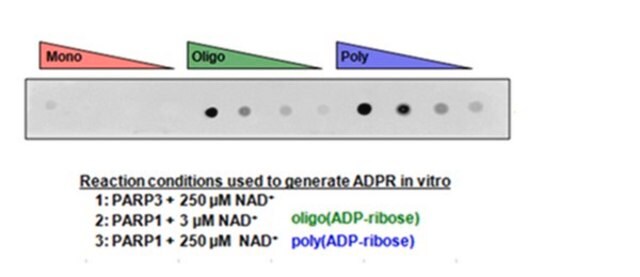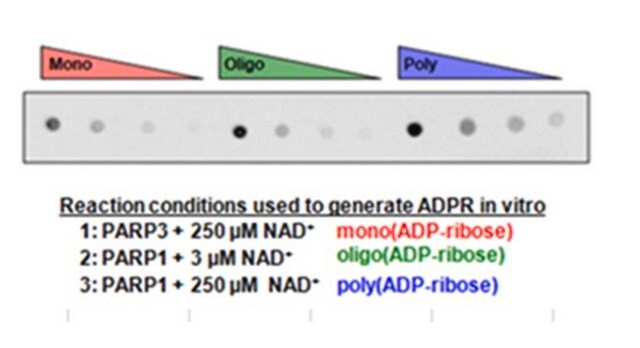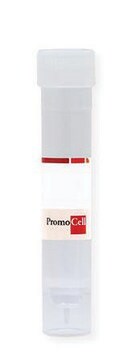MABE1076
Anti-mono- ADP-ribose binding reagent
from Escherichia coli
Synonim(y):
Binding Reagent
About This Item
Polecane produkty
pochodzenie biologiczne
Escherichia coli
Poziom jakości
forma przeciwciała
affinity isolated antibody
rodzaj przeciwciała
primary antibodies
klon
monoclonal
reaktywność gatunkowa
human, mouse
opakowanie
antibody small pack of 25 μg
metody
dot blot: suitable
western blot: suitable
Warunki transportu
dry ice
docelowa modyfikacja potranslacyjna
unmodified
Opis ogólny
Specyficzność
Zastosowanie
Epigenetics & Nuclear Function
Dot Blot Analysis: A representative lot detected mono-,-ADP-ribose modified proteins.
Dot Blot Analysis: A representative lot detected mono-ADP ribosylated proteins. (Courtesy of Lee Kraus, University of Texas Southwestern Medical Center).
Western Blotting Analysis: A representative lot detected mono-ADP-ribose modified protein by Wester blotting (Courtesy of Lee Kraus, University of Texas Southwestern Medical Center).
Jakość
Gel Electrophoresis Analysis: 0.5 µg of this binding reagent was analyzed on GEL Electrophoresis to test for purity.
Opis wartości docelowych
Postać fizyczna
Przechowywanie i stabilność
Inne uwagi
Oświadczenie o zrzeczeniu się odpowiedzialności
Nie możesz znaleźć właściwego produktu?
Wypróbuj nasz Narzędzie selektora produktów.
Kod klasy składowania
12 - Non Combustible Liquids
Klasa zagrożenia wodnego (WGK)
WGK 2
Temperatura zapłonu (°F)
Not applicable
Temperatura zapłonu (°C)
Not applicable
Certyfikaty analizy (CoA)
Poszukaj Certyfikaty analizy (CoA), wpisując numer partii/serii produktów. Numery serii i partii można znaleźć na etykiecie produktu po słowach „seria” lub „partia”.
Masz już ten produkt?
Dokumenty związane z niedawno zakupionymi produktami zostały zamieszczone w Bibliotece dokumentów.
Nasz zespół naukowców ma doświadczenie we wszystkich obszarach badań, w tym w naukach przyrodniczych, materiałoznawstwie, syntezie chemicznej, chromatografii, analityce i wielu innych dziedzinach.
Skontaktuj się z zespołem ds. pomocy technicznej






